It looks like you're using an Ad Blocker.
Please white-list or disable AboveTopSecret.com in your ad-blocking tool.
Thank you.
Some features of ATS will be disabled while you continue to use an ad-blocker.
31
share:
The ancient Minoans were a highly artistic civilization known for their beautiful art & architecture that dated back to 3000 BC.


I was looking at Minoan art until I stumbled upon particular pictures of a royal Minoan princess walking among her dark skinned servants…
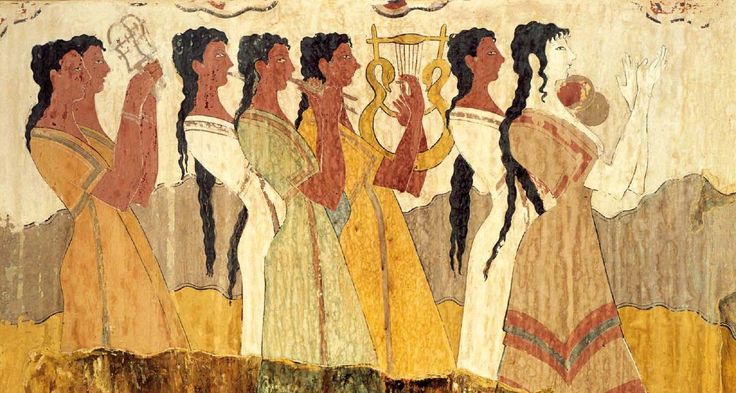
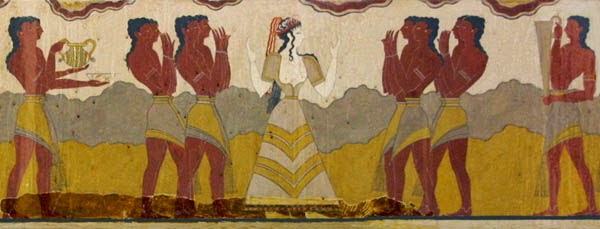
I thought it was really bizarre , Since I remember a while ago reading about the Minoan culture initially arriving from Egypt. So I look at what people said regarding the art.
some argued that in ancient art, men were generally portrayed with tanned skin while females were more light skinned , However we clearly see dark skinned female servants behind the princess in the picture above , also there are many light skinned men in Minoan art. So the second argument people made was that white color of skin just symbolized the status of the person , which definitely made sense.
But I wanted to see what scientists thought about Minoans and their origins. So I did a quick search on Minoan DNA and I found this Report by Nature.com , there were actually a bunch of them published on the same day.

On one of the the reports (published in 2013) scientists at the University of Washington done a series of female chromosomal DNA tests on ancient Minoan skeletons:
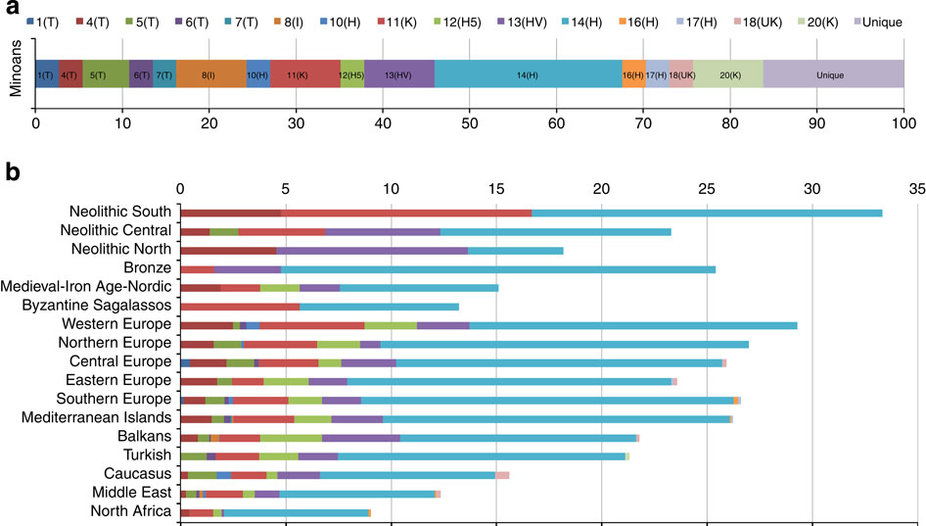
(For those who don't know the female chromosmal [mtDNA] haplogroups of H , T & K is predomanantly found amoung white-European woman. lets look at the maps)
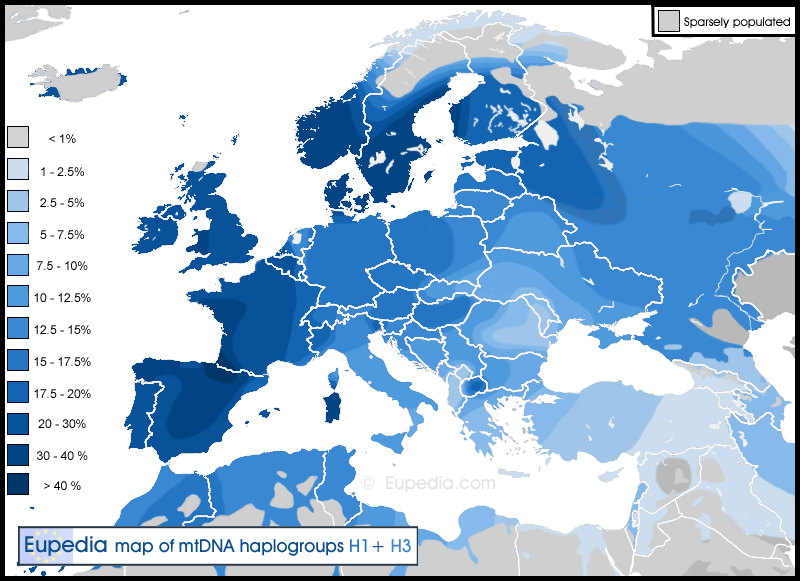
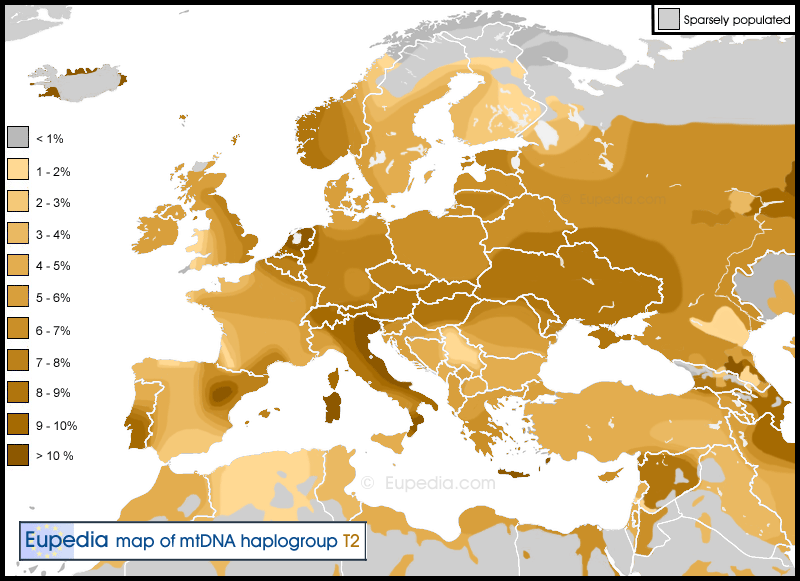
The Report continues...
I know this discovery isn’t new but it’s definitely another peace of the puzzle to some of these ancient mysteries & just thought I’d like to share this with you guys.
The fact that the Minonian culture & the Island of Crete played a major role in greek myth & legends is also very telling. If scientists can do some male chromosmal DNA tests on ancient Phoenician or Assyrian skeletons that might support the theory of an Indo-European invasion of South-Asia [mesopotamia & India] from the Caucus mountains. We also know that the ancient Phrygrians & Hittes were Indo-European but that's pretty much where archeologists draw the line due to the langauge barrier. There may very well be a chance that the early Phoenicians & Assyrians were Indo-European , but for now we'll have to wait and see.


I was looking at Minoan art until I stumbled upon particular pictures of a royal Minoan princess walking among her dark skinned servants…


I thought it was really bizarre , Since I remember a while ago reading about the Minoan culture initially arriving from Egypt. So I look at what people said regarding the art.
some argued that in ancient art, men were generally portrayed with tanned skin while females were more light skinned , However we clearly see dark skinned female servants behind the princess in the picture above , also there are many light skinned men in Minoan art. So the second argument people made was that white color of skin just symbolized the status of the person , which definitely made sense.
But I wanted to see what scientists thought about Minoans and their origins. So I did a quick search on Minoan DNA and I found this Report by Nature.com , there were actually a bunch of them published on the same day.

On one of the the reports (published in 2013) scientists at the University of Washington done a series of female chromosomal DNA tests on ancient Minoan skeletons:
"We studied skeletal remains from two Minoan populations, one in central Crete, the other in southern Crete. Following the application of a series of strict authentication criteria, we use for our comparisons the DNAs of only 37 Minoans whose remains were well preserved in a cave ossuary located in the Lassithi plateau of east-central Crete. For several statistical analyses, the modern populations were grouped to 71 geographic or ethnic groups , Twenty-one distinct Minoan mtDNA haplotypes were observed."
"Our calculations of genetic distances, haplotype sharing and principal component analysis (PCA) exclude a North African origin of the Minoans. Instead, we find that the highest genetic affinity of the Minoans is with Neolithic and modern European populations."
None of the Minoans carried the characteristic African mtDNA haplotypes of the L haplogroup (Supplementary Table S2).
figure shows graphically in the form of geographic density maps the shared mtDNA lineages between the Minoans and 71 extant population groups. Notice that the Minoans displayed the least sharing of haplotypes with North Africans.

Genetic affinity with Neolithic and modern European populations The Minoan mtDNA haplotypes resembled those of the European populations (Figs 2b, 3a and 4; Supplementary Figs S1–S3). The majority of Minoans were classified in haplogroups H (43.2%), T (18.9%), K (16.2%) and I (8.1%). Haplogroups U5A, W, J2, U, X and J were each identified in a single individual. The greatest percentage of shared Minoan haplotypes was observed with European populations, particularly with individuals from Northern and Western Europe (26.98% and 29.28%, respectively)
(For those who don't know the female chromosmal [mtDNA] haplogroups of H , T & K is predomanantly found amoung white-European woman. lets look at the maps)


The Report continues...
Notably, in Fig. 4, a gradient can be observed, with the lowest affinity for Minoans found with Northern African populations and the percentage of haplotype sharing increasing as we move through the Middle East, Caucasus and the Mediterranean islands, southern Europe and mainland Europe. Figure 5 illustrates the close relationship between the Minoans and the modern European populations. The ancient Minoan DNA was most similar to populations from western and northern Europe. The population showed particular genetic affinities with Bronze Age populations from Sardinia and Iberia and Neolithic samples from Scandinavia and France.
I know this discovery isn’t new but it’s definitely another peace of the puzzle to some of these ancient mysteries & just thought I’d like to share this with you guys.
The fact that the Minonian culture & the Island of Crete played a major role in greek myth & legends is also very telling. If scientists can do some male chromosmal DNA tests on ancient Phoenician or Assyrian skeletons that might support the theory of an Indo-European invasion of South-Asia [mesopotamia & India] from the Caucus mountains. We also know that the ancient Phrygrians & Hittes were Indo-European but that's pretty much where archeologists draw the line due to the langauge barrier. There may very well be a chance that the early Phoenicians & Assyrians were Indo-European , but for now we'll have to wait and see.
edit on 19-3-2017 by ancienthistorian because: (no reason given)
edit on 19-3-2017 by ancienthistorian because: (no reason
given)
Amazing,
I've always loved the Minoan culture. It is the mythic home of the Minotaur and bares the hallmarks of the Atlantis myth. Their ancient art was excellent, I esp. love the sea going motifs they used.
Hopefully this information wouldn't get politicized and used for some racial bias toward Western European genetic superiority. Like some of the theories of older New World inhabitants, before the proto-Indians of the earliest archeological records, being of European decent. These type of theories are often characterized as being Euro-centric and an excuse to claim rights as the original or first people of an area. Personally, I think theories like this get blown off too easily and too often, esp. with such hard evidence to support it. S&F
I've always loved the Minoan culture. It is the mythic home of the Minotaur and bares the hallmarks of the Atlantis myth. Their ancient art was excellent, I esp. love the sea going motifs they used.
Hopefully this information wouldn't get politicized and used for some racial bias toward Western European genetic superiority. Like some of the theories of older New World inhabitants, before the proto-Indians of the earliest archeological records, being of European decent. These type of theories are often characterized as being Euro-centric and an excuse to claim rights as the original or first people of an area. Personally, I think theories like this get blown off too easily and too often, esp. with such hard evidence to support it. S&F
She is "white" because she doesn't work. It has been a vanity symbol for longer than I had realized. But among the latina population here, being
light skinned is a big vanity thing indicating your mod of support is great enough you don't need to work, so your skin never tans.
originally posted by: Milehigh
a reply to: ancienthistorian
amazing thread, were the Minoans part of the later Sea people.
The Minoans fall is attributed in part to the Sea People, a combination of climate change and attacks by the Sea People lead to the downfall of all the great civilisations that existed at that time.
Egypt was the exception but they came close to collapse and were never the same again.
Apart from modern times the world the minoans lived in was the most globally connected.
Fascinating time in history it was
originally posted by: IkNOwSTuff
originally posted by: Milehigh
a reply to: ancienthistorian
amazing thread, were the Minoans part of the later Sea people.
The Minoans fall is attributed in part to the Sea People, a combination of climate change and attacks by the Sea People lead to the downfall of all the great civilisations that existed at that time.
Egypt was the exception but they came close to collapse and were never the same again.
Apart from modern times the world the minoans lived in was the most globally connected.
Fascinating time in history it was
You seem very knowledgeable on the subject, could you point me towards pertinent information regarding the sea people please.
originally posted by: Milehigh
originally posted by: IkNOwSTuff
originally posted by: Milehigh
a reply to: ancienthistorian
amazing thread, were the Minoans part of the later Sea people.
The Minoans fall is attributed in part to the Sea People, a combination of climate change and attacks by the Sea People lead to the downfall of all the great civilisations that existed at that time.
Egypt was the exception but they came close to collapse and were never the same again.
Apart from modern times the world the minoans lived in was the most globally connected.
Fascinating time in history it was
You seem very knowledgeable on the subject, could you point me towards pertinent information regarding the sea people please.
Isnt that the point though, there is no information about the sea people
All we know is that *some civilization* swopped in on the eastern med with boats and advanced weaponry, wrecked havoc on all the other civilizations there and *incidently* their rise and fall exactly match Platos history of Atlantis if you assume that he meant 900 years, not 9000 years.
originally posted by: merka
All we know is that *some civilization* swopped in on the eastern med with boats and advanced weaponry, wrecked havoc on all the other civilizations there and *incidently* their rise and fall exactly match Platos history of Atlantis if you assume that he meant 900 years, not 9000 years.
That's in interesting use of the term "exactly".
a reply to: bigfatfurrytexan
I wonder if it's a gender specific thing. Most men have no problem acquiring a "farmers" tan but the women are to be unblemished as possible.
I wonder if it's a gender specific thing. Most men have no problem acquiring a "farmers" tan but the women are to be unblemished as possible.
edit on 9-9-2017 by ancienthistorian because: (no reason given)
new topics
-
Can we be certain that Jesus Christ was born on December 25th?
Religion, Faith, And Theology: 1 hours ago -
RIP Merrily Harpur British Big Cat Realist
Cryptozoology: 3 hours ago -
Australian mercenary caught and crying as he is a prisoner of war.
Other Current Events: 9 hours ago -
JILL BIDEN Wants JOE to Punish Democrats Who Forced Him to Leave Office in Disgrace on 1.20.2025.
2024 Elections: 10 hours ago -
Panamanian President-“every square meter” of the Panama Canal belongs to Panama.
New World Order: 10 hours ago
top topics
-
The clotting is not going away latest
Medical Issues & Conspiracies: 16 hours ago, 10 flags -
NYPD arrests migrant who allegedly set woman on fire on subway train, watched her burn to death
Breaking Alternative News: 13 hours ago, 9 flags -
Panamanian President-“every square meter” of the Panama Canal belongs to Panama.
New World Order: 10 hours ago, 9 flags -
Australian mercenary caught and crying as he is a prisoner of war.
Other Current Events: 9 hours ago, 8 flags -
JILL BIDEN Wants JOE to Punish Democrats Who Forced Him to Leave Office in Disgrace on 1.20.2025.
2024 Elections: 10 hours ago, 6 flags -
RIP Merrily Harpur British Big Cat Realist
Cryptozoology: 3 hours ago, 3 flags -
Chef Gerald R. Ford
Food and Cooking: 16 hours ago, 2 flags -
Can we be certain that Jesus Christ was born on December 25th?
Religion, Faith, And Theology: 1 hours ago, 1 flags
active topics
-
Panamanian President-“every square meter” of the Panama Canal belongs to Panama.
New World Order • 10 • : xuenchen -
Can we be certain that Jesus Christ was born on December 25th?
Religion, Faith, And Theology • 6 • : xuenchen -
Why isn't Psychiatry involved?
Social Issues and Civil Unrest • 32 • : Xtrozero -
‘Something horrible’: Somerset pit reveals bronze age cannibalism
Ancient & Lost Civilizations • 18 • : McGinty -
Post A Funny (T&C Friendly) Pic Part IV: The LOL awakens!
General Chit Chat • 7946 • : baddmove -
NYPD arrests migrant who allegedly set woman on fire on subway train, watched her burn to death
Breaking Alternative News • 15 • : Xtrozero -
Australian mercenary caught and crying as he is a prisoner of war.
Other Current Events • 10 • : Xtrozero -
The clotting is not going away latest
Medical Issues & Conspiracies • 14 • : mysterioustranger -
Research paper about plasmoids specifically calls out missing MH370 flight
General Conspiracies • 5 • : Skinnerbot -
The Cost of True Discipleship—Count the Cost
Religion, Faith, And Theology • 7 • : TheGoodNews
31
